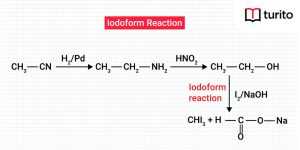Have you heard of oxyacids of sulphur? Oxy acids are those acids that contain oxygen atoms. Sulphur forms oxy acids like sulfoxylic acid, sulphurous acid, sulfuric acid, peroxy-sulfuric acid, thionic acid, etc. Can you tell which is the lowest member of these oxyacids of sulphur? What are its properties and structure? What are its uses? This section is all about the lowest member of sulphur oxoacids.
What Is Sulphurous Acid?
Sulphur is known for its large number of oxy acids. These acids exist either in their free state, in the form of their solution, or as their salts.
Now, to answer the question, what is sulphurous acid? In simple words, it can be said to be one of the oxyacids of sulphur. Oxyacids of sulphur are classified into three series. Among these three series, one is of sulphurous acid series.
The least powerful is sulfuric acid. Sulphur dioxide solution is another name for sulfuric acid. A dibasic acid, that is. In sulfuric acid, the S-atom is in the +4 oxidation state. Since this acid is unstable, it cannot be found in its free form. Only in solution is it understood.
Sulphurous Acid Structure
The molecular formula of sulphurous acid is H₂SO₃. It can also be written as OS(OH)₂. The sulphurous acid structure is given below:

H₂SO₃ is known as Sulphur dioxide solution, Dihydrogen trioxosulphate, or Tri-oxo sulfuric acid. As per the Lewis dot structure’s rules, the S-atom with the lowest electronegativity in the molecule is at the centre of the structure. There are two sulphurous acid structures, as suggested by the chemists. These are
1. Symmetrical structure:
Three O-atoms surround the S-atom in a symmetrical sulphurous acid structure. Two H-atoms are attached to two O-atoms forming hydroxide groups. And one O-atom forms a double bond or a coordinate bond with S-atom.
2. Unsymmetrical structure:
In an unsymmetrical sulphurous acid structure, the S-atom is surrounded by three O-atoms and one H-atom. The remaining H-atom is attached to any one O-atom forming a hydroxide group. And the other two O-atoms form two double or coordinate bonds with the S-atom.
Normally, both sulphurous acid structures exist in resonance with each other. The geometry of sulphurous acid is trigonal pyramidal.
Preparation of Sulphurous Acid
Sulphurous acid is believed to be a solution of SO₂ in water. There are two ways to prepare sulphurous acid. These are
Method 1: By using sulphur dioxide.
The solution of acid is obtained by dissolving SO₂ in water.
SO₂ + H₂O → H₂SO₃
Method 2: By using thionyl chloride.
H₂SO₃ can also be prepared by the action of water on thionyl chloride, SOCl₂.
SOCl₂ + 2H₂O → H₂SO₃ + 2HCl
Sulphurous Acid Properties
The list of some sulphurous acid properties is given below:
- The sulphurous acid solution gives a smell of SO₂, which evolved on heating the solution. Therefore, H₂SO₃ is present in equilibrium with free SO₂ gas.
H₂SO₃ ⇌ H₂O + SO₂
- When a saturated solution of SO₂ in H₂O is cooled to 3℃, crystals of hexahydrate, SO₂.6H₂O, separate.
- Acidic nature: It shows dibasic nature.
H₂SO₃ ⇌ H⁺ + HSO₃⁻
HSO₃⁻ ⇌ H⁺ + SO₃²⁻
- Decomposition: When the solution of sulphurous acid is heated in a sealed tube at 150℃, sulphur gets deposited.
3H₂SO₃ → 2H₂SO₄ + H₂O + S
- Reducing properties: It acts as a strong reducing agent. When it reduces a certain substance, sulphurous acid is oxidised to H₂SO₄ and gives nascent hydrogen.
H₂SO₃ + H₂O → H₂SO₄ + 2[H]
- Oxidising properties: It also acts as an oxidising agent. When it oxidises a certain substance, it is reduced to sulphur in most cases.
H₂SO₃ → S + H₂O + 2[O]
- Bleaching properties: As it acts as a reducing agent, it can liberate nascent hydrogen easily. This nascent hydrogen can render coloured matter into colourless matter, i.e., H₂SO₃ acts as a bleaching agent.
H₂SO₃ + H₂O → H₂SO₄ + 2[H]
- H₂SO₃ molecules can readily take up oxygen and sulphur atoms to form H₂SO₄ and H₂S₂O₃ (thiosulfuric acid).
H₂SO₃ + [O] → H₂SO₄
H₂SO₃ + [S] → H₂S₂O₃
- Action of Zn-dust: When H₂SO₃ is heated with Zn-dust, zinc hyposulfite (ZnS₂O₄) is obtained.
H₂SO₃ + Zn → ZnS₂O₄ + 2H₂O
Some Other Chemical Reactions of Sulphurous Acid
- H₂SO₃ reduces halogens (X) to their corresponding hydracids (HX).
H₂SO₃ + H₂O + X₂ → H₂SO₄ + 2HX
- Acidified solution of KMnO₄ is reduced to the MnSO₄ solution.
2KMnO₄ + 5H₂SO₃ → K₂SO₄ + 2MnSO₄ + 2H₂SO₄ + 3H₂O
- Acidified solution of K₂Cr₂O₇ is turned green due to the formation of Cr₂(SO₄)₃.
K₂Cr₂O₇ + H₂SO₄ + 3H₂SO₃ → K₂SO₄ + Cr₂(SO₄)₃ + 4H₂O
- Sulphurous acid reduces Fe₂(SO₄)₃ to FeSO₄.
H₂SO₃ + H₂O + Fe₂(SO₄)₃ → 2H₂SO₄ + 2FeSO₄
- It reduces the acidified solution of iodate to I₂.
5H₂SO₃ + 2KIO₃ → 4H₂SO₄ + K₂SO₄ + H₂O + I₂
- Sulphurous acid oxidises H₂S to S and is reduced to S.
H₂SO₃ + 2H₂S → 3S + 3H₂O
- At 1000℃, H₂ is oxidised to H₂O and H₂SO₃ is reduced to S.
H₂SO₃ + 2H₂ → S + 3H₂O
- H₂SO₃ reduces itself to sulphur while oxidising SnCl₂ and Hg₂Cl₂ to SnCl₄ and HgCl₄, respectively.
H₂SO₃ + 2SnCl₂ + 4HCl → S + 3H₂O + 2SnCl₄
H₂SO₃ + 2Hg₂Cl₂ + 4HCl → S + 3H₂O + 4HgCl₂
Neutralising Sulphurous Acid
The process of neutralising sulfonic acid is carried out in the following ways:
- Pour sulfonic acid slowly into the aqueous solution of alkali hydroxide. Stir the solution continuously while adding the acid.
In commercial operations, this process may be carried out intermittently or continuously.
- At room temperature or under normal conditions, it reacts with alkyl carbonates. And it neutralises sulphurous acid.
- A 50% caustic soda solution can also neutralise sulphurous acid. A yellowish paste is obtained by reacting 50% caustic soda solution with sulphurous acid.
Sulphurous Acid Uses
There is very little to prove the existence of sulphurous acid, so there are some sulphurous acid uses. These are
- Sulphurous acid is a strong reducing agent. It has a +4 oxidation state that can oxidise up to +6 when sulphurous acid reduces other substances.
- It can reduce chlorine to hydrochloric acid.
- It can be oxidised to sulphate or sulfuric acid by accepting another oxygen atom.
- It is used to bleach straw and paper products, such as hats and bags.
- It is used as a good disinfecting agent.
Toxicity of Sulphurous Acid
Apart from sulphurous acid uses, there are some toxicity issues. In adverse cases,
- It can be a dermal toxin and result in skin burns.
- It can also cause inflammation of the lungs influenced by inhalation of toxic gases and vapours or metal fumes.
- It can also cause gastrointestinal problems such as diarrhoea, hypermotility, etc.
- Some cases are recorded when people experience nausea or vomiting after inhaling sulphurous acid fumes.
Points to Remember About Sulphurous Acid
- Its pure form is not available.
- It is a poor inorganic acid known by the treatment kituo.
- It is considered a sulphur dioxide solution in water.
- It has a Trigonal Pyramidal structure.
- Its solution gives the smell of SO₂.
- It exists in solution form.
- It is a tautomer of sulfonic acid.
- On burning, it gives a pungent sulphur odour.
- It is also obtained by reacting SOCl₂ with water.
- Upon heating at 150℃, it can decompose into water, sulfuric acid, and sulphur.
- The major component of sulphurous acid is acid rain.
- The boiling point of H₂SO₃ is -60℃.
- It is corrosive to tissue and metals.
- It is a diprotic acid and can donate two protons, i.e., two H⁺ ions.
- It is the conjugate acid of hydrogen sulphite.
- The molar mass of sulphurous acid is 82.07 g/mol.
Conclusion
To conclude, sulphurous acid is a sulphur oxoacid. No direct document proves this acid’s existence in solutions, but the molecule has been detected in the gas phase. It is an abrasive oxoacid of sulphur and a tautomeric form of sulfonic acid. Because pure, anhydrous sulphurous acid (H₂SO₃) cannot be outlined, aqueous sulphur dioxide solutions are often referred to as sulfurous acid.
They are used as reducing agents and disinfectants. As it releases carcinogen fumes of sulphur, which are toxic, sulphurous acid is a carcinogen acid of sulphur. If you inhale its fumes or come into contact with sulfurous acid, it is necessary to seek medical advice.
Frequently Asked Questions
1. Is sulphurous acid strong or weak?
A. Weak acids dissociate partially in the water, resulting in an equilibrium state containing the weak acid and its ions. H₂SO₃ in the aqueous state does not dissociate entirely into H3O⁺ or H⁺ and bisulfite ions. It means that the bisulfite ion is relatively stronger in preserving a proton (H⁺) when there is a base, for instance, water. Hence, sulphurous acid (H₂SO₃) is a weak acid.
2. Does sulphurous acid cause health hazards?
A. Sulphurous acid is a corrosive chemical. Besides its uses, sulfurous acid causes some health hazards.
- Direct contact with sulfurous acid can cause severe irritation and burn the skin.
- It can even cause damage to your eyes.
- On inhalation, sulphurous acid can irritate your throat and nose.
- Breathing sulfurous acid, H₂SO₃ can irritate your lungs.
- It can also cause coughing or shortness of breath.
3. Which one is the stronger acid: sulphurous acid or sulfuric acid?
A. Sulphurous acid (H₂SO₃) and sulfuric acid are diprotic acids, which result in two protons (H⁺) on division. Still, sulfuric acid (H₂SO₄) is a powerful acid. It is because the first proton dissociation is most favoured in it compared to H₂SO₃.

Relevant Articles
Butanoic Acid – Structure, Properties, Uses
Butanoic Acid The carboxylic acid, butanoic acid, has the structural …
Butanoic Acid – Structure, Properties, Uses Read More »
Read More >>What is Iodoform? Characteristics and Uses
Iodoform The formula for Iodoform is CHI3. It is biotic …
What is Iodoform? Characteristics and Uses Read More »
Read More >>Lattice Energy – Explanation, Factors & Formulas
Lattice Energy Lattice energy evaluates the intensity of the ionic …
Lattice Energy – Explanation, Factors & Formulas Read More »
Read More >>Lead Acetate – Definition, Properties, Uses
Lead Acetate Have you ever licked lipstick when you sketch …
Lead Acetate – Definition, Properties, Uses Read More »
Read More >>




















Comments: